I’ve spent the last few months testing the Turtleback Expedition trailer after buying it new in the summer of 2020. Besides reviewing just this specific Turtleback trailer for our daily-life offroading and camping adventures, we also used it as a general proxy to test whether this category of RV makes sense for prepping.
We’ve logged over 2,000 miles with the Expedition across multiple states, climates, and terrain types, including the ridgelines above Sedona, Arizona, the high country of Colorado’s national forests, and the famous offroading trails in Moab, Utah. Temps have ranged from 10-110 F.
Trying something new — here’s a quick video summary:
The verdict, up front:
- We’re happy with the Expedition and have been recommending it to the many people who stop us to ask what it’s about.
- The core build quality is great. There’s some fit-and-finish stuff we’re unhappy with, such as the swing door and latch for the picnic table area, but overall it’s fine.
- In an emergency where we’d leave our home in a vehicle, this is what we’re hooking up and taking with us (even over other available RV options like a fifth-wheel) because it’s robust enough to keep us comfortable on the road but small and agile enough to go places other RVs can’t — and we personally value flexibility over luxury in an emergency.
You should consider buying an offroad trailer for prepping if you check all of these boxes:
- You have a legit offroad and tow-capable vehicle, like a Jeep Wrangler or truck, since there’s no point in spending the extra cost for off road features if you can’t actually take it off road.
- You spend time outdoors as part of normal, non-emergency life and will get constant use from the trailer. Don’t buy this just for prepping — you could do so much more with $20-40k instead.
- You can store the trailer on or very near your property, since the value of it as a prep goes way down if you have to keep the RV stored far enough away from home that you can’t quickly get to it, hook up, and leave.
You might’ve heard that the camping and RV industry is exploding this year as people find ways to get out of the house while avoiding air travel and crowds.
Many people naturally wonder if the same vehicle or trailer they get for recreation can also serve as part of their emergency prepping — a kind of thoughtful ‘two birds, one stone’ purchase that gets you more bang for your buck.
My family was in the same bucket. We were already avid car and backcountry campers with access to a 40-foot fifth wheel (a big tow-behind camper). But we didn’t have anything we felt good about as a prep, particularly when it comes to offroading or “overlanding.”
And, due to the surge in campers this year, it was getting harder to find available spots in our area, whether reserved or ‘wild’. That means we need to go where others can’t in order to find good spots.
From CNN: The latest tend in RV’ing is getting way off the grid
Off-road capabilities are they key difference
The Turtleback style of overlanding trailers — part of a wave of influence from Australian and South African overlanding companies making their way to the US — are the most “offroady” you can can get in the world of RVs without spending over $500k.
So although we’ve looked deeply into standard options like teardrop trailers and RVs in the Class A, B, and C range, including the increasingly-popular ‘van life’ models like the 4×4 Sprinter, we eventually purchased a smaller tow-behind trailer that’s specifically built for offroading.
Most other types of RVs can handle a basic dirt road. Think “if a basic car can do it, so can an RV.” But you’d buy something like the Turtleback specifically to go places the other types can’t.
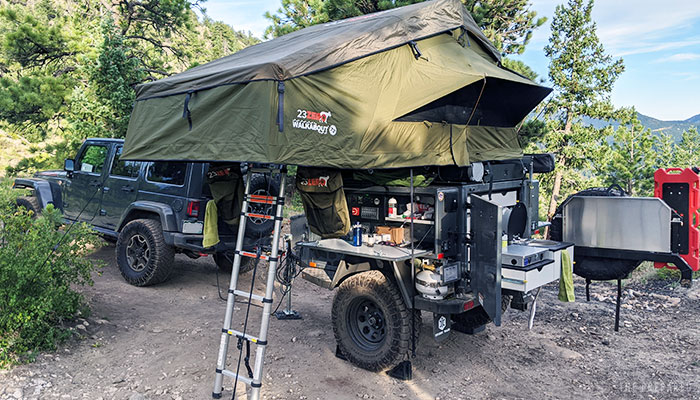
Reality check: The chances you’d actually need or benefit from a RV in a survival scenario are small and more on the SHTF end of the spectrum, such as a natural disaster that forces you to leave your area.
The chances are even smaller that the ability to go off road makes a meaningful difference in your survival.
For example, if you’re driven from your home due to a hurricane, you might take your RV to a Walmart parking lot or friend’s house a few states away. Traffic might be bad, but it’s probably fine that you don’t have an off-road vehicle.
On the other hand, you might face a scenario where traffic or other road blockages and debris are hurting your survival chances. Or you want to get away from other people in the chaotic main evacuee areas.
We’ve experienced this first hand in a major exodus, where we were able to go up and over a rocky berm near the interstate and shave 6 hours off an otherwise 12-hour bottleneck.
So while the chances are small that the money you pay for offroading features makes a difference in a real survival situation, I personally feel it’s worth it to have the flexibility to go almost anywhere. It’s definitely helpful for getting away from the crowds when camping.
Specs
Phoenix-based Turtleback has two models: the smaller Getaway for $12-25k and the larger Expedition starting at $27k.
The model and extras we tested came in around $42k because we wanted to try some of the premium add-ons: an amazing tent, upgraded suspension and tires, external shower enclosure, extra batteries, solar charging, wrap-around awnings and walls to create more ‘interior’ space, and more.
Note: Turtleback is part made-in-the-US manufacturer and part “puts the pieces together for you.” So while they build things like the frame and body, they also buy and install third-party components that you choose (like the tent and awning). So this review technically covers a bunch of companies — eg. 23 Zero and Zamp Solar — and the price includes all of those extras. The only expenses we had left were a few miscellaneous things such as bed covers and kitchen stuff.
This 15-minute video from Turtleback is a good overview:
Our build is almost identical to the one shown, except we run our fridge in the back of the main vehicle (not in the trailer storage) and he skips over some extras (eg. picnic table storage area). There’s too much to list everything here, but the major points are:
- About the footprint of a normal parking space: 13’ long by 6.5’ wide by 7.5’ tall (depending on tires and tent)
- Dry weight around 3,500 pounds
- 48 gallons of water, including 6 gal in the water heater
- 210 amp-hours of power across two AGM deep cycle marine batteries
- 90 watt deployable briefcase solar panel
- 2,000 watt inverter with two “normal” power plugs
- 16 pounds of propane (11 in main tank + 5 in extra tank)
- Soft/folding Roof Top Tent
- 270-degree wrap-around awning
- Kitchen area with two large prep surfaces and lots of storage
- Two gas stoves
- Sink
- External shower with privacy curtain
- Lots of lighting and USB power outlets
- Pass-through main storage area
- Dedicated storage for folding-leg picnic tables and poles / fishing rods
- Space for extra fuel and water via Rotopax accessories
- Spare tire mount (can also be used for bike racks etc)
Offroading and overlanding features
The three elements that matter most for offroading trailers:
- Is the hitch / attachment point between vehicle and trailer flexible enough to bend and move off road?
- Is the suspension and ground clearance good enough to handle unpredictable terrain?
- Is the general build quality (eg. frame welds) good enough to stand up to constant abuse?
Overall, we’re quite impressed with how well the Turtleback handled rough terrain and feel like it can do almost anything our aftermarket “rock crawling” Jeep can do. We were able to get to places that honestly surprised us and bystanders. For example, we camped on a ridgeline high above Sedona where long-time local dirt bikers told us they’d never seen another RV get to before.
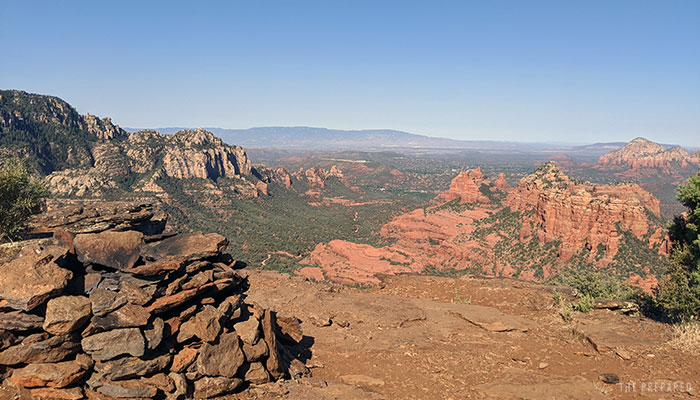
If you’re experienced with the general 1-9 rating system used to rank offroading difficulty: Our Jeep can comfortably handle a 7, and we’d take the Expedition on trails up to a 5 in daily life but feel like it could handle a 6-7 if needed.
Hitch
Typical tow-behind campers use the kind of ball-joint hitch you’re familiar with: the metal orb about the size of a tennis ball that fits in a simple socket. Those hitches can easily rotate left and right — picture a bird’s eye view of a trailer while turning around a corner — but they don’t handle up and down or twisting well.
That’s why offroad trailers use hitches with full range of motion. In this case, the Turtleback uses the excellent Max Coupler hitch that fits in a standard 2” tow receiver.
Suspension
I asked Barry, one of the leaders of Turtleback, what he thought the biggest area of innovation / competition would be in the overlanding trailer market over the next years.
“Suspension!”
I was a little surprised to hear that, but now understand why. The industry pretty much knows how to make a solid steel frame and bolt on extras like a water tank. To stay competitive, companies are investing in how well the trailer handles extreme terrain while also being a smooth ride on road.
Many companies are working with reputable suspension companies for branded partnerships. In Turtleback’s case, they’ve partnered with ICON.
This optional upgrade was expensive, adding $2,000 or roughly 5% to the overall price. But it was so worth it. On-road driving is smooth yet it can handle most anything off-road that our souped-up Jeep could.
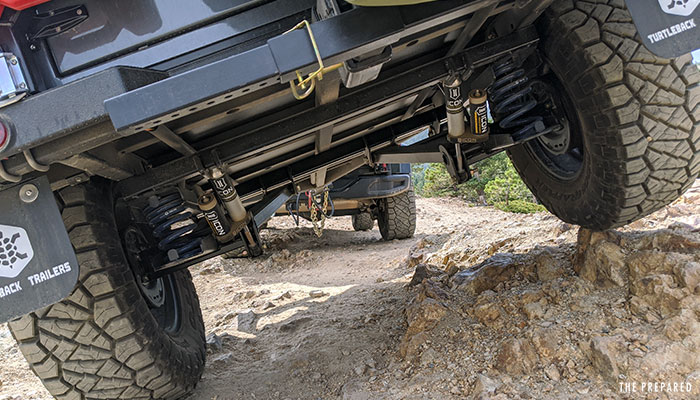
Ground clearance
Aside from suspension, you want as much height as possible between the ground and everything on the trailer besides the tire. The more space underneath, the larger obstacles you can drive over.
Some of this depends on tire size. In my case, I put 35” Nitto Ridge Grappler tires on the trailer — the same model I use on my Jeep. The larger 35” tire adds a few inches of clearance compared to a normal tire.
The rest depends on the trailer design. Turtleback did a solid job here, as there’s nothing hanging down or ruining ground clearance that shouldn’t be.
Build quality
Going off road is hard on vehicles. The constant vibrations and forces torquing from all kinds of angles can easily cause problems over time, such as bolts slowly loosening in critical areas.
While there were some fit-and-finish things about the Turtleback’s build I was unhappy with (more on that later), I saw nothing to be worried about in the core areas that matter for offroading, such as the frame, welds, suspension attachments, etc.
Shelter
It’s one thing to have a simple tent. But the Turtleback with add-ons from 23 Zero can turn from a seemingly-small box into enough shelter that rivals some studio apartments — when fully deployed, you get around 300 square feet of liveable, customizable shelter.
Tent
There are overlanding trailers that are built for sleeping on the inside of the main compartment, such as the AOR Sierra, but the Turtlebacks put a separate tent on the top (called a Roof Top Tent).
Either style is fine and comes down to personal preference and physical ability, such as having a dog you want to sleep inside with you but that can’t climb a ladder or be hoisted up by hand. Google around if you want more on the pros and cons between them, including the difference between a hard- and soft-shell RTT.
We splurged and got a massive soft-shell-style tent called the 23 Zero Walkabout 72, featuring a California King memory foam mattress with waterproof bottom (helps with condensation) and a special coating that blacks out exterior light and reduces sun heat.
The light-suppression tech is particularly great. No more waking up at sunrise as the light hits your tent!
Bonus annex under the tent
Soft RTTs fold in half during storage. When deployed, half of the tent base is hanging out over the side of the foundation.
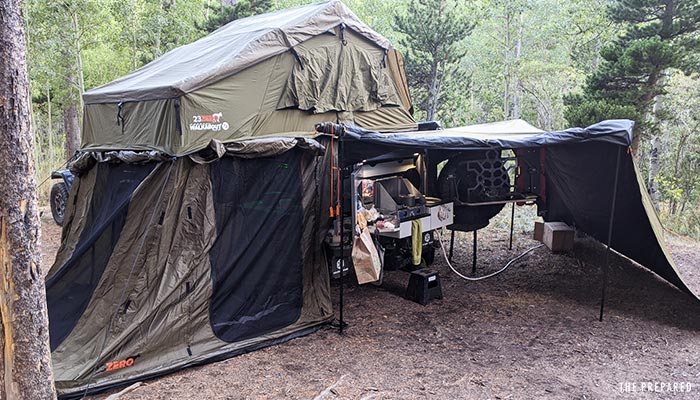
Not only does this give you a little shelter underneath the tent base — which is the same area as the main control panel on the Expedition trailer — but there’s a thoughtful add-on that zips around that overhead platform, creating a secondary tent on ground level. This bottom tent is fully enclosed, so even if you don’t need the extra sleeping space, it keeps your ladder and entrance / command center area sheltered from the elements. That kind of sheltered privacy could come in very handy in an emergency.
Wrap-around awning and bonus walls
Another 23 Zero product, the Peregrine Awning, quickly expands to create 270 degrees of overhead sun and rain protection. You can quickly deploy the awning and leave it free standing, but there are integrated poles and included guy lines for stability.
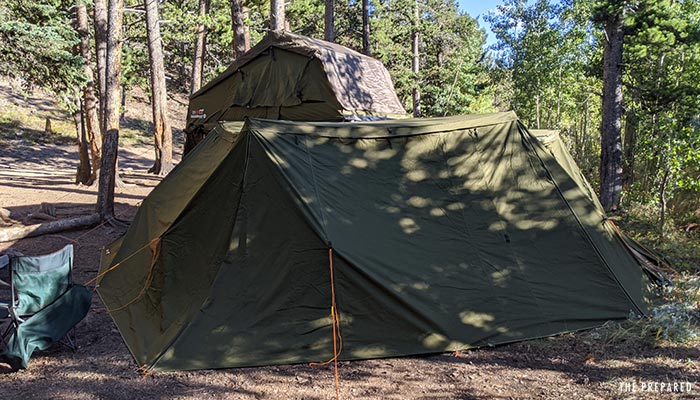
We also got the extra “walls” that zip to the overhead awning and reach to the ground at a slant. When fully deployed, the awning and walls create a huge amount of “interior” space that wraps from the kitchen / back side all the way around to where the trailer meets your vehicle.
The interior space is large enough to comfortably put two standard picnic tables and some chairs while still having access to the kitchen. There’s thoughtful zip-up panels to create doors and openings within the walls, such as around the kitchen area when cooking.
Setup and teardown
Once we got the hang of things, we could pull into a spot and be deployed in 5-10 minutes, including leveling then deploying the main tent, kitchen, and command center areas. That excludes the extra walls and annex described above, which would take another 10-15 minutes.
Breaking down camp is about the same.
If you go with a Roof Top Tent, know that there can be some climbing involved. Soft clamshell RTTs typically take a few more steps/minutes to unfold compared to a hardshell RTT that have smaller footprints and just pop straight up.
Other than some overhead/climbing efforts with the tent — which honestly aren’t bad for the physically-able — everything else is a breeze.
Living in and around the trailer
Power
With the upgraded dual-battery system and semi-portable solar charger, we had enough power to run the fridge, water pump, lights, and misc USB devices indefinitely. The batteries lasted around 4-5 days of normal use without any top-ups along the way.
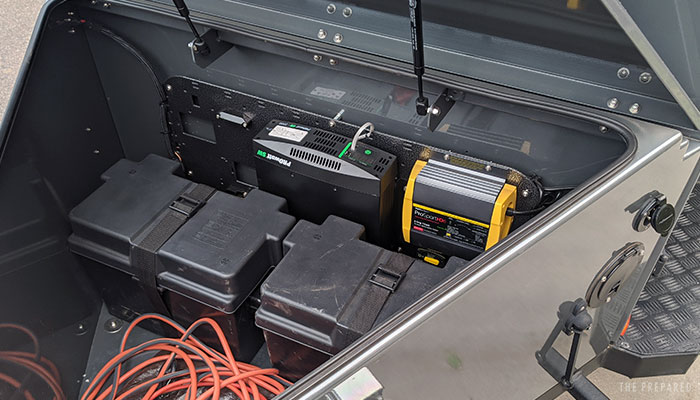
If you were in an emergency and worried about power, we feel confident that you’d be able to meet your core needs indefinitely — as long as you’re not crushing the batteries with something like an electric space heater or in a constant low-sun environment.
Although most of the electrical system was designed well by Turtleback, one of the components they use is a major gripe. The portion of the command center that shows battery draw and reserves was inaccurate, confusing, and hard to use — often leaving us wondering how much juice we actually had left.
Shower
Many RVs have an external hose hookup that can act as a shower. Turtleback takes it a step further with a custom arm that swings out over the shower area. Mounted to that arm is the 23 Zero shower curtain. You just unzip, swing out two arms, and the “shower stall” rolls down to the ground.
Although we didn’t do much showering on basic 1-2 night local camping trips, we did use it on longer expeditions and would definitely value it in an emergency.
Spending a few weeks as an evacuee is hard enough, and people often underestimate how valuable creature comforts like hygiene can be. Sure, you should have wet wipes and soap in your bug out bag, but nothing beats hot running water.
My main gripe with the shower is that, due to its location, the water runoff that just falls onto the ground can make the area muddy around your tongue jack (which holds up the front of the whole trailer), ladder, and command center.
But there’s really no other place Turtleback could put it, since the tent takes up the rest of the left side of the trailer, the kitchen takes all of the back, and the awning covers the right.
We reduced this problem by using extra leveling blocks (that we carry anyway) to create a kind of semi-porous floor where you’d stand while showering, with a rollable bath mat on top to make it comfortable on the feet. The water still gets through to the ground, but that setup kept the runoff much more contained.
Kitchen
Kitchen design is one of the areas where you see the most difference from one manufacturer to the next. We picked Turtleback in part because we liked their layout.
For example, one of the benefits of the Turtleback over similar competitors is the amount and layout of surface prep area around the kitchen. You get around 10 feet of linear countertop when fully deployed — and the majority of that space is kept clean on the inside of the trailer when driving down the road.
Another thoughtful design is the multi-layered propane safety system, which prevents gas from building up inside the trailer when closed up and automatically shuts off the burners if you absentmindedly pull out the kitchen shelves hanging over the cooktop area.
The two-burner stove runs hot — no wimpy stove woes — and has built-in windscreens.
The sink drains down to the ground, but it comes with a hose attachment so you can divert the runoff away from camp. This helps keep predator-attracting food smells further away too.
Other notes
For the price point, I was disappointed with some of the “fit and finish” in the build quality. The core build was fantastic — I have no problems with the welds, wiring, etc. But some of the smaller details were underwhelming, such as the water heater lid, brackets for awning and shower, the seal around the kitchen sink, the small swing door on the water intake ports, etc.
Some trailers have a wheel on the front jack so that you can make small adjustments to the nose as you’re trying to hook up the trailer and vehicle. The Turtleback doesn’t. The biggest time suck in the setup and teardown process was trying to back the car up for perfect alignment.
The Expedition weighs more than you might expect. It can get up to 4,000 pounds depending on your build configuration, how much water you’re carrying (a full tank is 380 extra pounds), and misc gear. The tow capacity on my four-door upgraded Wrangler is 3,500-3,700 pounds. We could definitely feel the vehicle struggling at high speeds on high-grade climbs, such as I-70 through the Rocky Mountains.

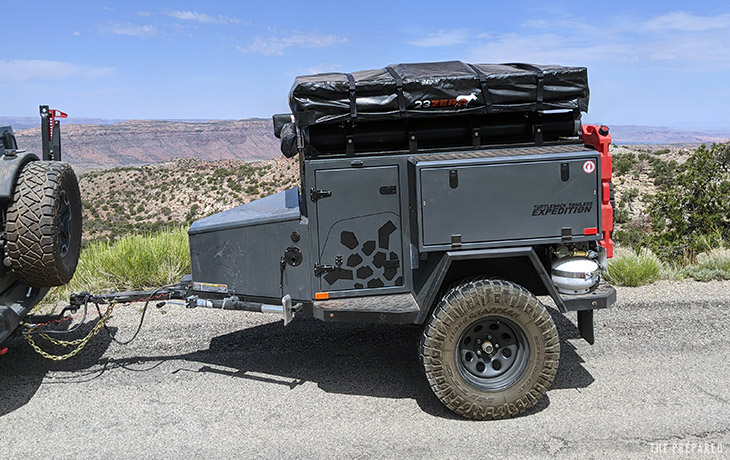
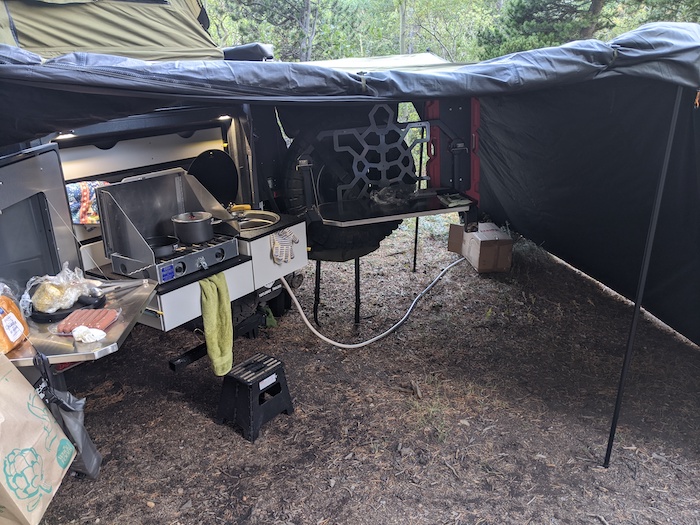
You are reporting the comment """ by on